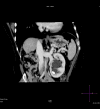A Case of Left Renal Vein Ligation in a Patient with Solitary Left Kidney Undergoing Liver Transplantation to Control Splenorenal Shunt and Improve Portal Venous Flow
- PMID: 29018183
- PMCID: PMC5652891
- DOI: 10.12659/ajcr.905719
A Case of Left Renal Vein Ligation in a Patient with Solitary Left Kidney Undergoing Liver Transplantation to Control Splenorenal Shunt and Improve Portal Venous Flow
Abstract
BACKGROUND Adequate portal venous flow is required for successful liver transplantation. Reduced venous flow and blood flow 'steal' by collateral vessels are a concern, and when there is a prominent splenorenal shunt present, ligation of the left renal vein has been recommended to improve portal venous blood flow. CASE REPORT A 51-year-old man who had undergone right nephrectomy in childhood required liver transplantation for liver cirrhosis and hepatocellular carcinoma due to hepatitis C virus (HCV) infection. The patient had no other comorbidity and no history of hepatorenal syndrome. At transplantation surgery, portal venous flow was poor and did not improve with ligation of shunt veins, but ligation of the left renal vein improved portal venous flow. On the first and fifth postoperative days, the patient was treated with basiliximab, a chimeric monoclonal antibody to the IL-2 receptor, and methylprednisolone. The calcineurin inhibitor, tacrolimus, was introduced on the fifth postoperative day. On the sixteenth postoperative day, renal color Doppler ultrasound showed normal left renal parenchyma; hepatic Doppler ultrasound showed good portal vein flow and preserved hepatic parenchyma in the liver transplant. CONCLUSIONS This case report has shown that in a patient with a single left kidney, left renal vein ligation is feasible and safe in a patient with no other risk factors for renal impairment following liver transplantation. Modification of postoperative immunosuppression to avoid calcineurin inhibitors in the very early postoperative phase may be important in promoting good recovery of renal function and to avoid the need for postoperative renal dialysis.
Conflict of interest statement
Figures
Similar articles
-
Left renal vein ligation for large splenorenal shunt during liver transplantation.ANZ J Surg. 2017 Oct;87(10):767-772. doi: 10.1111/ans.14044. Epub 2017 Aug 29. ANZ J Surg. 2017. PMID: 28851020 Review.
-
Left Renal Vein Ligation for Spontaneous Splenorenal Shunts During Deceased-Donor Orthotopic Liver Transplant Is Safe and Can Mitigate Complications from Portal Steal: A Case Series.Exp Clin Transplant. 2021 Apr;19(4):374-377. doi: 10.6002/ect.2018.0096. Epub 2018 Nov 28. Exp Clin Transplant. 2021. PMID: 30501587
-
Ligation of left renal vein as a salvage procedure for splenorenal shunt after living donor liver transplantation: a case report.Transplant Proc. 2009 Dec;41(10):4243-5. doi: 10.1016/j.transproceed.2009.08.054. Transplant Proc. 2009. PMID: 20005377
-
Liver transplantation with renoportal anastomosis after distal splenorenal shunt.Arch Surg. 2000 Dec;135(12):1401-4. doi: 10.1001/archsurg.135.12.1401. Arch Surg. 2000. PMID: 11115340
-
Renal-portal vein shunt for renal failure after left renal vein ligation in children: a review.J Urol. 1995 Oct;154(4):1491-4. J Urol. 1995. PMID: 7658574 Review.
References
-
- Gontarczyk GW, Łagiewska B, Pacholczyk M, et al. Intraoperative blood flow measurements and liver allograft function: preliminary results. Transplant Proc. 2006;38:234–36. - PubMed
-
- Lee SG, Moon DB, Ahn CS, et al. Ligation of left renal vein for large spontaneous splenorenal shunt to prevent portal flow steal in adult living donor liver transplantation. Transpl Int. 2007;20:45–50. - PubMed
-
- Golse N, Mohkam K, Rode A, et al. Surgical management of large spontaneous portosystemic splenorenal shunts during liver transplantation: Splenectomy or left renal vein ligation? Transplant Proc. 2015;47:1866–76. - PubMed
-
- Golse N, Bucur PO, Faitot F, et al. Spontaneous splenorenal shunt in liver transplantation: results of left renal vein ligation versus renoportal anastomosis. Transplantation. 2015;99:2576–85. - PubMed
Publication types
MeSH terms
LinkOut - more resources
Full Text Sources
Medical




